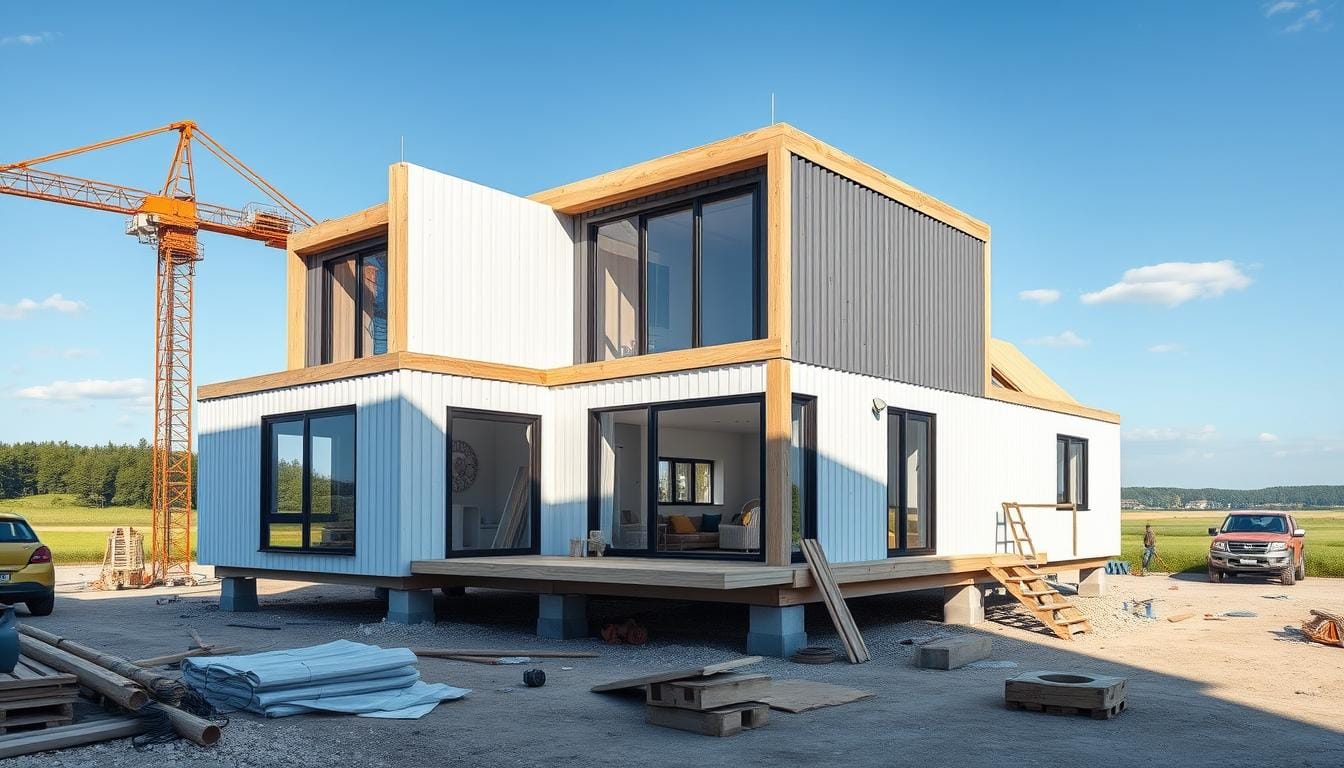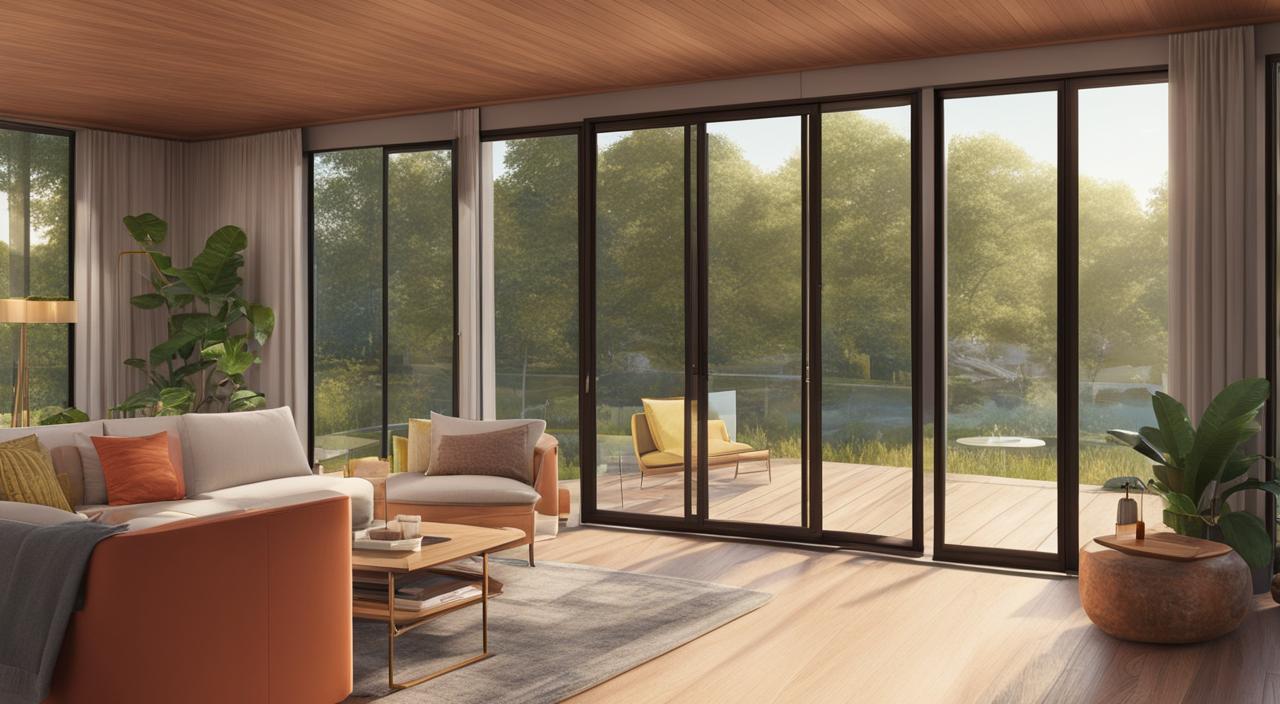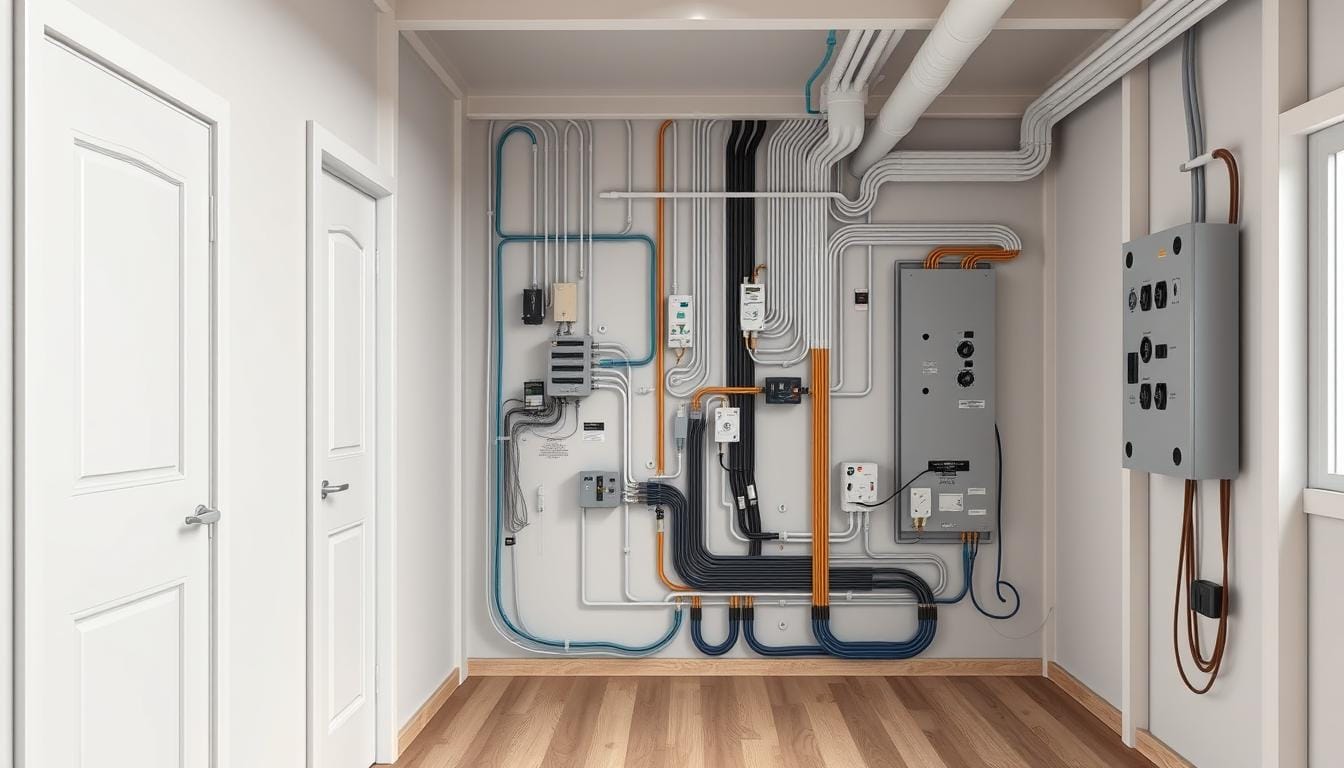Building a modular home is a new way to build homes. It’s fast, efficient, and flexible. These homes are made in parts in a factory. This means better quality and less time to build than regular homes.
Modular homes are also good for the planet. They are affordable and green. They use materials that save energy and cut down on waste.
Key Takeaways
- Modular homes are built in a factory and then moved to the site for assembly.
- They are cheaper than building a home on-site.
- Building a modular home is much quicker, often taking just weeks.
- They use less energy, saving money on bills over time.
- They are made with sustainable materials and produce less waste.
Understanding Modular Homes
Modular homes have changed the housing world. They offer great value, flexibility, and efficiency. Built in factories, they meet strict building codes, ensuring quality like traditional homes. Let’s look into what makes modular homes special and how they differ from regular houses.
What is a Modular Home?
A modular home is built in sections, or modules, in a factory. This method ensures high precision and quality. Once built, the modules are moved to the site for assembly. Modular homes must meet the same building standards as traditional homes, making them a reliable choice.

Benefits of Modular Homes
Modular homes are built much faster than traditional homes. The fabrication and installation can take just a few months. This is because they are built in a controlled environment, reducing waste and costs.
They are also very energy efficient. This is because they are well-insulated and air-tight, saving a lot of energy. Modular homes can be customised in many ways, meeting different lifestyle needs.
Differences Between Modular and Traditional Homes
Modular and traditional homes must follow the same building codes. But, they are built differently. Traditional homes are built on-site, facing delays and cost increases due to weather and other site issues. Modular homes, built in a factory, avoid these problems.
Modular homes are also more affordable, with costs between £300 – £1,500 per square meter. Traditional homes cost between £1,500 – £3,000 per square meter. Modular homes are often better insulated, making them quieter and more comfortable. They can be customised to fit individual tastes, making them popular for those who value modern living.
Understanding the prefab home industry and the benefits of modular homes helps homeowners make better choices. These choices can fit their budgets and lifestyle needs.
To learn more about designing your own modular home, visit Prefab Market.
The Designing Process
The designing process of modular homes is key. It involves detailed planning and talking things over. Here, homeowners can see their ideas take shape, making sure they fit local rules.
Every detail, from the layout to the smallest feature, is carefully planned. This ensures the home is perfect in every way.

Planning Your Modular Home
Planning a modular home means knowing the design basics. You need to think about several things first:
- Site Engineering: This costs $12,000–$18,000 and takes 8–12 weeks.
- Council Permits: These can cost $4,000–$10,000 and take 12–24 weeks.
- Structural Engineering: This might add $1,500–$3,000.
Choosing what you want takes 4–8 weeks. You also need to pay a 5% deposit of the total cost.
Popular Design Styles
Modular homes come in many styles:
- Minimalist: Focuses on simplicity and using space well.
- Contemporary: Features modern looks and new materials.
- Traditional: Offers a classic look that fits anywhere.
You can pick the style that suits you best. This way, you get a home that looks great and works well.
Customisation Options
Modular homes let you customise a lot. You can make your home truly yours with bespoke construction:
- Materials: Pick from top-quality options for inside and outside.
- Colour Schemes: Choose colours that show your style.
- Finishes: Add your own touches to floors, cabinets, and more.
With so many options, your home can be made just for you. It will be personal and special.
Financing Your Modular Home
Building and financing a modular home has many costs and options. It’s a sustainable way to build homes. Knowing about costs, financing, and government grants can help you save money.

Costs to Consider
When you finance a modular home, think about these costs:
- Module Costs: The main cost of the modules and customisations.
- Land Acquisition: Buying land for your modular home.
- Foundation Setting: Creating a strong foundation for the home.
- Assembly: The cost of putting the modules together on-site.
These costs can affect your budget a lot. You can get up to 75% of the home’s value as a loan. The income needed for a loan is between 4.5 to 5.5 times. Also, modular homes might need planning permission, which can make financing harder.
Available Financing Options
There are many ways to finance affordable modular homes:
- Modular Home Loans: Loans that pay out in stages, fitting modular construction well.
- Ecology Mortgages: Offers mortgages for modular homes, even before the panels are built.
- Bad Credit Mortgages: People with poor credit can get loans for modular homes, but options are fewer.
Ecology works with four modular makers to offer mortgages for off-site builds. Their approach supports sustainable, energy-efficient homes. They have mortgages like C-Change to encourage building homes that save money in the long run.
Government Grants and Schemes
The UK Government has grants and schemes for modular homes:
- Help to Build: Offers financial help for buying modular homes. You can work with mortgage brokers to find lenders.
- Sustainability Incentives: Agile Homes and HebHomes help build energy-efficient homes with renewable materials.
The Government wants new homes to cut carbon emissions by 75% by 2025. Modular homes fit this goal well. Working with lenders and makers like Ecology, you can get mortgages and other financing options.
Financing a modular home is easier than you think. With many options and government support, affordable modular homes are possible for many.
Choosing a Location
Deciding where to place your modular home is a big step. It needs careful thought. We’ll look at what to consider to find the best spot, meet planning rules, and be close to what you need.
Finding Suitable Land
Checking if the land is right is key when picking a spot for your modular home. A study on the land’s shape, current buildings, and local rules is important. Some land features, like slopes, might cost more to deal with. Also, tests to see if the land can hold the foundation are essential.

Local Planning Regulations
It’s vital to know the rules for building modular homes before buying. Local laws can affect your project a lot. They might even stop your build. Knowing these rules can avoid legal problems. A guide can help understand these rules better.
Accessibility and Amenities
Choose a place that’s easy to get to and has what you need nearby. This makes your home more enjoyable. But, rural areas might have delivery issues. Yet, they often have beautiful views that add value.
Thinking about these points helps your home build go smoothly. It also makes sure your home is in a place that suits you perfectly.
Construction of Modular Homes
Building modular homes is all about precision and control. It uses efficient methods to ensure speed and quality. This approach not only saves money but also helps the environment by using fewer resources and less carbon.

The Assembly Process
Modular home assembly starts in a factory. Here, each module is built using advanced methods and strong materials. This controlled setting means less waste and better quality than traditional building.
Once the modules are ready, they’re moved to the site for assembly. This method is quicker and ensures higher quality.
[Read more about modular home assembly]
Quality Control Measures
Quality is key in the modular home industry. In the factory, each module is checked thoroughly. This ensures it meets national standards and any special needs.
These checks continue when the modules are assembled on-site. Experts check for strength and precision. This careful process makes modular homes strong and weather-resistant.
Project Timelines
Building modular homes is much faster than traditional methods, often up to 50% quicker. This is because modules are built and the site is prepared at the same time. The use of efficient techniques also helps speed up the process.
This means homeowners can move in sooner. Modular homes are a reliable and quick way to get a new home.
As more people look for affordable, eco-friendly homes, modular homes are a great solution. They offer quality, efficiency, and a quicker way to own a home.
Living in a Modular Home
Living in a modular home brings many benefits beyond just building it. It’s great for saving energy and living sustainably. This makes homes comfortable and good for the planet.
Energy Efficiency and Sustainability
Modular homes are built to save energy. They have strong insulation and are very airtight. This cuts down on heating costs and helps the environment.
Many are even net-zero, with high EPC ratings. They use new designs to use less energy. Even though some materials come from far away, these homes are very efficient.
Maintenance and Upkeep
Keeping prefab homes in good shape is easy. They’re made with durable materials and modern methods. They come with 10-year warranties, like NHBC Buildmark, for extra peace of mind.
Looking after them is simple. The quality control during making makes upkeep easy. It’s also easy to add on to these homes as your needs change.
Community and Lifestyle Considerations
Modular homes fit well into communities that value sustainability and community. These areas focus on building strong social bonds and eco-friendly living. They match today’s lifestyle goals.
These homes can grow with you. They adapt to changing needs, keeping communities happy and engaged for years.




